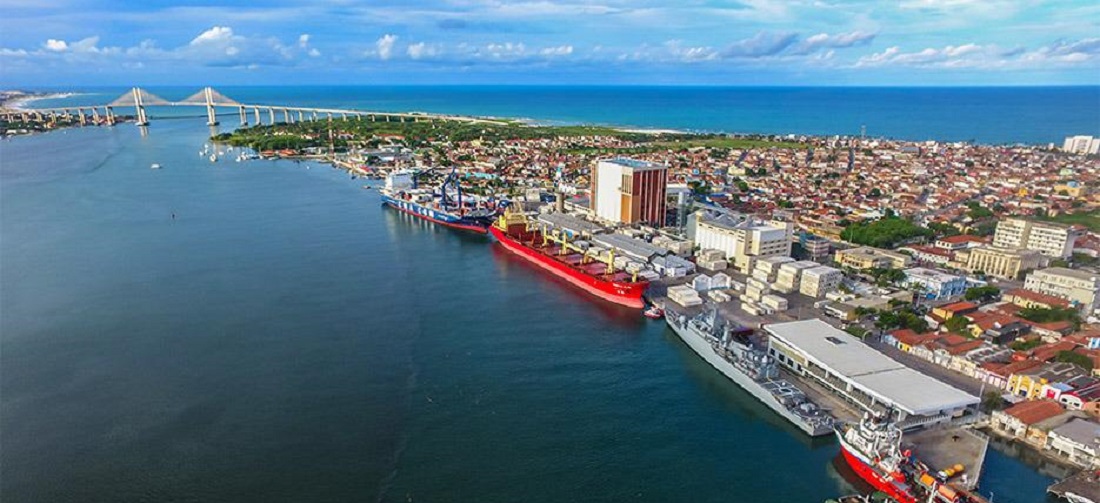
Port of Natal Begins Emergency Dredging to Ensure Fruit Export Flow
Apr, 29, 2025 Posted by Denise VileraWeek 202519
On Monday (April 28), the Port of Natal received the dredger Ortelius, which will remove a sandbank that had blocked access to the maritime terminal and was responsible for the grounding of a cargo ship in 2023. The intervention is being executed by Jan De Nul, a company hired on an emergency basis without a bidding process, for R$ 6.4 million. The goal is to remove 700,000 cubic meters of sediment, which will be dumped 4 kilometers off the coast. The operation is expected to last up to five days.
Paulo Henrique Macedo, CEO of Companhia Docas do Rio Grande do Norte (Codern), which manages the port, explained that dredging is essential to prevent new groundings and ensure the safe flow of fruit exports. This service is distinct from the larger dredging project planned for the second half of the year, which aims to increase the draft from 10 meters to 12.5 meters. A 12-meter draft will only be possible after reinforcing the bridge fenders and maintaining the access channel.
Initially, the plan was to wait for the main dredging operation. “But we realized we couldn’t wait, given the high risk of ships being unable to maneuver,” Macedo said.
According to him, the sandbank is one of the port’s main vulnerabilities. After meetings with the Port Authority and Agrícola Famosa (a fruit exporting company), Codern committed to its removal to ensure the flow of the upcoming fruit harvest, which begins in August. “In the second half of the year, the main dredging operation—still pending public bidding—will be carried out to maintain the channel,” Macedo added.
The Ortelius has twice the capacity of the dredger previously used for the Ponta Negra beach nourishment project. “With a greater ability to hold sediment, the dredger will require fewer trips to the coast, speeding up the process,” explained Paulo Sidney, Codern’s technical and commercial director. He also emphasized the requirement that the dredger’s tank have a minimum capacity of 3,000 cubic meters, which enhances accumulation and operational efficiency.
The dredging operation comes at a time of strong prospects for fruit production in Rio Grande do Norte. “Last year, Agrícola Famosa used the port without issues, but this intervention is necessary to avoid surprises. We expect more than double the volume of fruit shipped through the Port of Natal this season,” Macedo said.
During the 2024/2025 harvest, the terminal handled 131,537.43 tons of fruit—more than double the 46,417.78 tons shipped the previous season. Agrícola Famosa introduced a new palletized shipment method, which has been a success in Europe, helping preserve the quality of the fruit during transportation.
As a result, the company has already requested a lease of the South Yard to further establish the Port of Natal as a major fruit export hub. “This intervention is essential because the vessels hired for the new harvest are equipped to carry a much larger number of pallets and containers,” Macedo concluded.
In addition to sand removal, the operation will include a bathymetric survey (underwater depth measurement) to evaluate the effectiveness of the dredging.
The public tender for the main dredging project scheduled for the second half of the year was published in the Diário Oficial da União (Federal Official Gazette) earlier this month. Proposals will be opened on June 25. The estimated cost is R$54.5 million, and the work is expected to last up to six months.
The dredging will deepen the port’s draft and allow access for larger vessels. The access channel to the Port of Natal is 3 kilometers long and has a minimum width of 100 meters in straight sections, expanding to 120 meters in curved areas.
Source: Tribuna do Norte
-
Ports and Terminals
Jun, 27, 2022
0
Port of Santos employees protest for salary increases, annual days off
-
Grains
Oct, 06, 2021
0
Soybeans: Brazil to export 2.68 million tons in October
-
Ports and Terminals
Apr, 28, 2022
0
The government of Maranhão signed a partnership with Santos Brasil
-
Ports and Terminals
Sep, 02, 2021
0
21 port authorities win the Portos + Brasil award for management excellence

